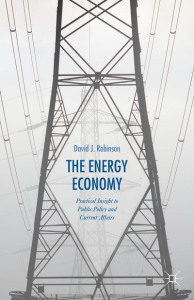
The following is an adapted excerpt from “The Energy Economy, Practical Insight to Public Policy and Current Affairs” by David J. Robinson, principal of the Montrose Group, LLC. It was published by Palgrave MacMillan in August of 2015.
Americans use 19 percent of the world’s energy. This energy usage is driven by the industrial nature of the American economy. From an economic development standpoint, not all states have equal levels of consumption and costs for energy. Large, industrialized states of Texas, California, Ohio, New York, Pennsylvania, Illinois, North Carolina, Michigan and Indiana top the US states in energy consumption. Cold-weather northern states use more natural gas to heat their homes and businesses, while southern states consume substantial amounts of electricity to cool these same types of facilities in the warm summers.
Beyond levels of consumption, the cost of energy is a top factor impacting corporate site location decisions of companies considering where to locate jobs and investment. Energy availability and costs rank in the top 10 of corporate site location consultant factors. The cost of energy varies among the different states, and it varies with sources of energy as well. Idaho, Wyoming, Washington, Utah and Kentucky offer the best electric rates, and New Hampshire, New York, Alaska, Connecticut and Hawaii offer the highest.
The cost and reliability of a region’s transportation fuel impact transportation and logistics firms, as America consumes 27 percent of its energy in transportation. Oil constitutes 93 percent of America’s transportation costs, and small business owners have found high fuel costs to be an impediment to economic growth. South Carolina, Arkansas, Oklahoma, Wyoming, Alabama, and Tennessee offer the lowest gasoline prices, and, much like other sources of energy, the East and West Coast offer the highest gasoline prices.
Energy-intensive industry sectors are strong candidates for retention and attraction campaigns for regions and states with low energy costs. Companies in the chemical, aluminum, cement, iron, steel, paper and pulp, glass and refining sectors provide high-wage manufacturing jobs, but cannot operate in a region with high energy costs. Chemical factories, as an example, have 80 percent of their costs tied to energy, and energy-intensive industries constitute just over 2/3 of all global energy use.
The Power of Deregulation?
Nature and policymakers both impact the energy cost of a region and state. Most regions in America have access to an affordable source of energy based upon available natural resources such as water, geothermal, shale, oil, natural gas, wind, solar, biomass, oil or natural gas. The Tennessee Valley Authority (TVA) is an example of a multi-state region that capitalized on federal resources to capture the power of water to provide low-cost energy. Today, the TVA serves 155 government cooperative power distributors and directly serves 57 large industrial or government installations.
The TVA is an economic development giant that plays a major role in retaining and attracting high-energy companies with power costs 16 percent below the national average, stimulating $5,900,000,000 in business investments. Shale oil and renewable sources have a chance to play the same role as the TVA for the regions having access to these power sources.
Whether a region has direct access to a large pool of energy from natural resources or not, state policymakers can decide whether their regions have low or high costs for power. Traditionally, the costs of power are driven by state policymaker decisions about whether to adopt a regulatory or deregulatory model for electric and natural gas service. Either approach can produce low-cost power.

Utility regulatory models that treat electric and natural gas companies as a monopoly permit these companies to offer service without competition but at an agreed upon price. Even these states that regulate utilities as a natural monopoly offer special economic development incentives for energy-intensive companies. These companies gain reduced rates for electric and natural gas service in exchange for the promise of job creation and capital investment. The larger the job creation and capital investment, the larger the energy price reduction for energy-intensive companies.
Nearly half the states have deregulated power utility services and leave it to the market to set retail rates for electric and natural gas services. A great debate is raging among policymakers about whether the regulated or deregulated approach creates lower energy costs. Either approach can work, but policymakers have to make challenging choices when it comes to driving down energy costs.